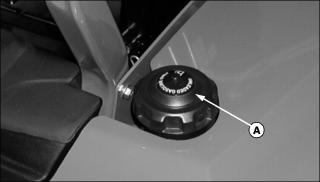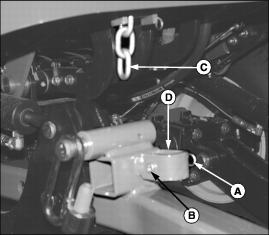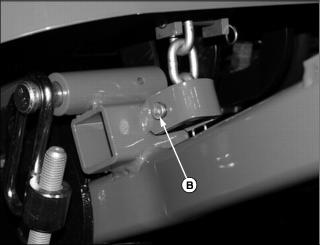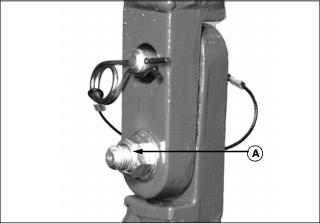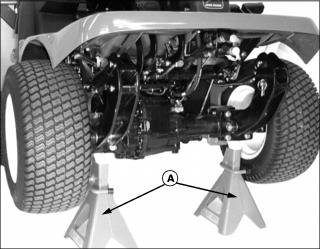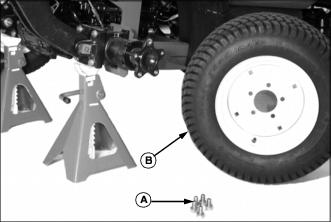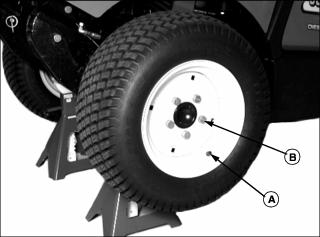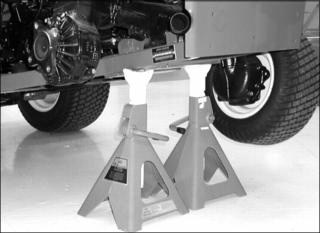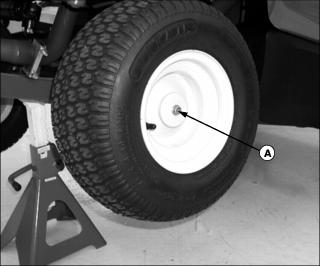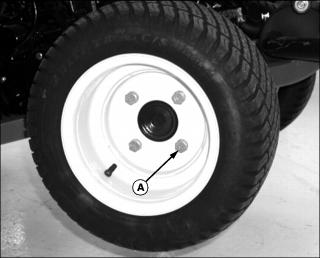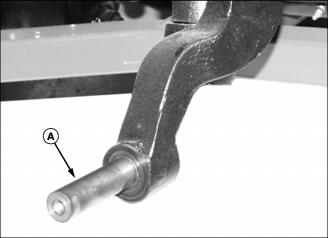PIN TC1420G010001, TC1435D010001, TC1445D010001
Introduction
Product Identification
Safety
Operating Machine
Replacement Parts
Service Intervals
Service Lubrication
Service Engine
Service Transmission
Service Steering & Brakes
Service Electrical
Service Miscellaneous
Cleaning and Repairing Metal Surfaces
Cleaning and Repairing Plastic Surfaces
Removing and Installing Front Wheels
Removing and Installing Rear Wheels
Troubleshooting
Storage
Assembly
Specifications
Warranty
John Deere Quality Statement
Service Record
CopyrightŠ Deere & Company

Service Miscellaneous
Filling Fuel Tank
Add stabilizer to fuel before using it in your machine to prevent engine damage due to stale fuel. Follow directions on stabilizer container.
1. Park machine safely. (See Parking Safely in the Safety section.)
2. Remove any debris from area around fuel tank cap (A).
4. Fill tank with fresh, stabilized fuel only to bottom of filler neck.
Using Service Latches
1. Raise mower deck to highest level.
2. Park machine safely. (See Parking Safely in the Safety section.)
3. Remove spring pin (A) and drilled pin (B) from mower deck lift arm.
4. Insert bottom link of service latch chain (C) into welded bracket (D) on mower deck lift arm.
5. Install drilled pin (B) through bracket and chain, and secure with spring pin.
Cleaning and Repairing Metal Surfaces
Cleaning
Follow automotive practices to care for the painted surfaces of your machine. Use a high-quality automotive wax regularly to maintain the factory look of painted surfaces.
Repairing Minor Scratches (Surface Scratches)
1. Clean area to be repaired thoroughly.
2. Use automotive polishing compound to remove surface scratches.
3. Apply wax to entire surface.
Repairing Deep Scratches (Bare Metal or Primer Showing)
1. Clean area to be painted with rubbing alcohol or mineral spirits.
2. Use paint stick with factory-matched colors available from your John Deere dealer to fill scratches. Follow directions included on paint stick for use and for drying.
3. Smooth out surface using an automotive polishing compound. Do not use power buffer.
Cleaning and Repairing Plastic Surfaces
Your John Deere dealer has the professional materials needed to properly remove surface scratches from any plastic surfaces, do not attempt to paint over marks or scratches in plastic parts.
1. Rinse hood and entire machine with clean water to remove dirt and dust that may scratch the surface.
2. Wash surface with clean water and a mild liquid automotive washing soap.
3. Dry thoroughly to avoid water spots.
4. Wax the surface with a liquid automotive wax. Use products that specifically say "contains no abrasives."
5. Buff applied wax by hand using a clean, soft cloth.
Tightening ROPS Hardware
1. Park machine safely. (See Parking Safely in the Safety section.)
2. Raise ROPS to upright position and insert lock pins.
3. Tighten the ROPS attaching bolts (A) to 40 Nˇm (30 lb-ft).
Removing and Installing Front Wheels
Raising Front of Machine
1. Park machine safely. (See Parking Safely in the Safety section.)
2. Remove attachment from machine.
4. Using a floor jack on frame behind front wheel, lift machine until front tire is off the ground. Do not use jack on transaxle or oil filter may be damaged.
5. Install jack stands (A) under left and right side of front axle.
Removing Front Wheels
1. Remove front wheel bolts (A) and washers.
2. Remove front wheel (B) from front axle.
Installing Front Wheels
1. Install wheels onto axle hubs with valve stems (A) facing outward. Make sure there is a lock washer installed on each wheel bolt (B), and install bolts into wheel and hub.
2. Tighten front wheel bolts to 225 Nˇm (165 lb-ft) using a torque wrench.
3. Lower machine to ground and remove floor jack.
4. Remove wheel blocks from rear tires.
ˇ After traveling 30m (100 ft) while changing direction.
ˇ Often during the next 100 hours of operation.
Removing and Installing Rear Wheels
ˇ Ensure machine is stable on floor jack before lifting. ˇ Lower machine onto jack stands before loosening wheel bolts. |
Raising Rear of Machine
1. Park machine safely. (See Parking Safely in the Safety section.)
2. Using a floor jack at center of rear frame, lift machine until rear tires are off of ground. Alternatively, the rear frame plate (A) can be used as a jacking or lifting point, but care must be taken not to damage the muffler (B).
3. Install jack stands under left and right side of rear frame.
4. Lower machine onto jack stands.
Removing Rear Wheels - 2WD
1. Remove rear wheel bolt and washer (A) from center of rear wheel.
2. Pull wheel and tire assembly straight off of rear axle.
Removing Rear Wheels - 4WD
1. Remove wheel bolts and washers (A). Remove wheel from rear axle.
Installing Rear Wheels - 2WD
1. Apply recommended grease to rear axle shaft (A) before installing rear wheel.
2. Install rear wheel onto axle hub with valve stem facing outward.
3. Install washer and wheel bolt (B). Tighten rear wheel mounting bolt to 82 Nˇm (60 lb-ft) using torque wrench.
4. Raise machine up at center of rear frame. Remove jack stands, and lower machine to the ground.
Installing Rear Wheels - 4WD
1. Install rear wheel onto axle hub with valve stem facing outward.
2. Install washer and wheel bolt. Tighten rear wheel mounting bolts (A) to 225 Nˇm (165 lb-ft) using torque wrench.
3. Jack machine up at center of rear frame. Remove jack stands, and lower machine to the ground.

